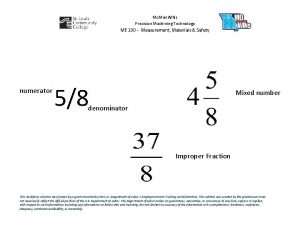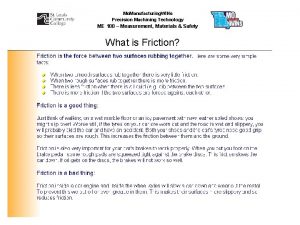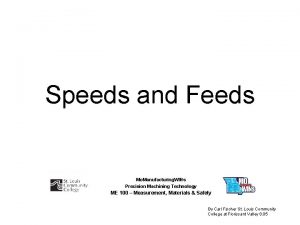Mo Man WINs Precision Machining Technology ME 100





- Slides: 5

Mo. Man. WINs Precision Machining Technology ME 100 - Measurement, Materials & Safety Abrasive Grinding This workforce solution was funded by a grant awarded by the U. S. Department of Labor’s Employment and Training Administration. The solution was created by the grantee and does not necessarily reflect the official position of the U. S. Department of Labor. The Department of Labor makes no guarantees, warranties, or assurances of any kind, express or implied, with respect to such information, including any information on linked sites and including, but not limited to, accuracy of the information or its completeness, timeliness, usefulness, adequacy, continued availability, or ownership. This work is licensed under the Creative Commons Attribution 4. 0 International License. To view a copy of this license, visit http: //creativecommons. org/licenses/by/4. 0/. See page 539 in text

Grinding wheel properties Grinding Wheel Markings. pdf Abrasive Type – Aluminum Oxide or Ceramic Aluminum Oxide for - Steel Silicon Carbide (green or black wheels) – carbide, cast iron, nonferrous metals Grit/Grain Size from 8 - 600 Lower the number the courser the wheel Courser for softer material Finer for harder materials Courser wheel = rougher finish Grade from A – Z A is the softest Soft wheel for hard material Hard wheel for soft material Structure from 1 – 16 1 is the Densest wheel (grains closest together) Bond type Vitrified - most common – used for high precision Silicate – synthetic, releases grains easily Rubber – can operate at high speeds and produce finish Diamond and CBN(Cubic Boron nitride) expensive wheels for very hard materials

Grinding Wheel Shapes

When handling or using grinding wheels Do; Handle and store wheels in a careful manner. Observe the 3 basic rules of “no rolling, no dropping, and no contact with other objects”. Store wheels on a shelf or storage rack in a dry place. Before mounting a wheel onto a machine, perform a visual inspection and ring test (hammering test) to check for cracks, chips, and other problems. Check that the maximum operating speed, dimensions, and other specifications of the grinding wheel are correct for the machine where it will be used. Use the blotters that are supplied with the wheels. The blotters should be larger than the flange diameter and must not be stained or torn. Be sure that the work rest is properly adjusted. The wheel should be no more than 3 mm away from the work rest and 3 – 10 mm away from the adjustment piece. Wear safety goggles, dust-proof mask, and other necessary protective gear during operation. In order to avoid disrupting the balance, completely shut off the coolant before stopping the wheel rotation. Use shield plates or other means to protect operators from sparks.

When handling or using a grinding wheel Don’t; If the hole diameter of the grinding wheel does not match the machine, do not force the wheel onto the machine or alter its hole diameter. Do not exceed the maximum operating speed that is marked on the wheel. Do not use mounting flanges if the surfaces which contact the grinding wheel are deformed, scratched, dirty, or corroded. Do not use flanges that do not have roll-offs. If the wheel is attached by nuts, do not use flanges (base plates) that have roll-offs. When mounting onto the flanges, do not over-tighten the nuts. Do not use the side of the wheel unless the wheel is specifically designed for that purpose. Do not start the machine before the grinding wheel cover is installed. Do not use excessive force to press the workpiece against the grinding wheel, or the grinding wheel against the workpiece. Do not directly touch a rotating grinding wheel with any part of your body. During test operation, do not stand in front of the grinding wheel direction of rotation. When working with a portable grinder, do not place the grinder onto a table, floor, workpiece, or other surface before the grinding wheel has fully stopped. Do not perform grinding in a location where there is the risk of ignition or explosion.








